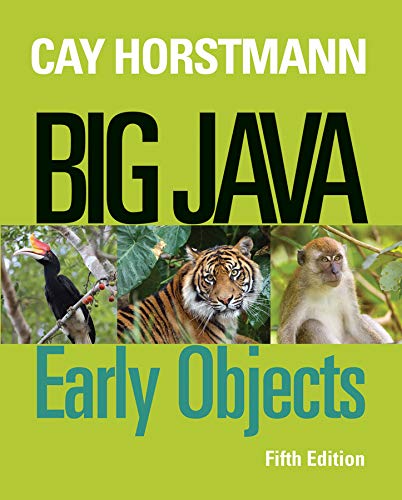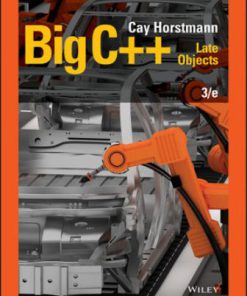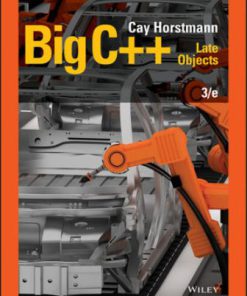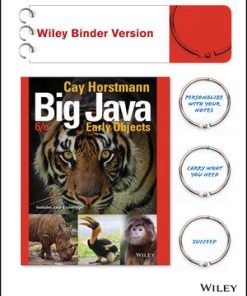Test Bank For Big Java: Early Objects 5th Edition
$35.00 Original price was: $35.00.$26.50Current price is: $26.50.
Test Bank For Big Java: Early Objects 5th Edition
Instant download Test Bank For Big Java: Early Objects 5th Edition pdf docx epub after payment.

Product details:
- ISBN-10 : 111842297X
- ISBN-13 : 978-1118422977
- Author: CAY S. HORSTMANN
This book introduces programmers to objects at a gradual pace. Optional example modules are included using Alice and Greenfoot. The examples feature annotations with dos and don’ts along with cross references to more detailed explanations in the text. New tables show a large number of typical and cautionary examples. New programming and review problems are also presented that ensure a broad coverage of topics. Cay will also add sections on problem solving, and a new, more approachable and visual design developed for JfE and BJLO is used.
Table of contents:
PREFACE iii
SPECIAL FEATURES xxii
CHATER 1 INTRODUCTION 1
1.1 Computer Programs 2
1.2 The Anatomy of a Computer 3
1.3 The Java Programming Language 6
1.4 Becoming Familiar with Your Programming Environment 8
1.5 Analyzing Your First Program 12
1.6 Errors 15
1.7 Problem Solving: Algorithm Design 16
CHATER 2 USING OBJECTS 33
2.1 Objects and Classes 34
2.2 Variables 36
2.3 Calling Methods 43
2.4 Constructing Objects 48
2.5 Accessor and Mutator Methods 50
2.6 The API Documentation 52
2.7 Implementing a Test Program 55
2.8 Object References 57
2.9 Graphical Applications 61
2.10 Ellipses, Lines, Text, and Color 66
CHATER 3 IMPLEMENTING CLASSES 81
3.1 Instance Variables and Encapsulation 82
3.2 Specifying the Public Interface of a Class 86
3.3 Providing the Class Implementation 93
3.4 Unit Testing 102
3.5 Problem Solving: Tracing Objects 105
3.6 Local Variables 107
3.7 The this reference 109
3.8 Shape Classes 112
CHATER 4 FUNDAMENTAL DATA TYPES 131
4.1 Numbers 132
4.2 Arithmetic 139
4.3 Input and Output 147
4.4 Problem Solving: First Do it By Hand 154
4.5 Strings 156
CHATER 5 DECISIONS 179
5.1 The if Statement 180
5.2 Comparing Values 186
5.3 Multiple Alternatives 196
5.4 Nested Branches 200
5.5 Problem Solving: Flowcharts 207
5.6 Problem Solving: Selecting Test Cases 210
5.7 Boolean Variables and Operators 213
5.8 Application: Input Validation 218
CHAPTER 6 LOOPS 241
6.1 The While Loop 242
6.2 Problem Solving: Hand-Tracing 249
6.3 The For Loop 254
6.4 The Do Loop 262
6.5 Application: Processing Sentinel Values 263
6.6 Problem Solving: Storyboards 269
6.7 Common Loop Algorithms 272
6.8 Nested Loops 279
6.9 Application: Random Numbers and Simulations 283
6.10 Using a Debugger 286
CHAPTER 7 ARRAYS AND ARRAY LISTS 311
7.1 Arrays 312
7.2 The Enhanced For Loop 321
7.3 Common Array Algorithms 322
7.4 Problem Solving: Adapting Algorithms 331
7.5 Problem Solving: Discovering Algorithms By Manipulating Physical Objects 336
7.7 Array Lists 347
7.8 Regression Testing 356
CHATER 8 DESIGNING CLASSES 379
8.1 Discovering Classes 380
8.2 Designing Good Methods 381
8.3 Problem Solving: Patterns for Object Data 390
8.4 Static Variables and Methods 395
8.5 Packages 400
8.6 Unit Test Frameworks 407
CHAPTER 9 INHERITANCE 421
9.1 Inheritance Hierarchies 422
9.2 Implementing Subclasses 426
9.3 Overriding Methods 431
9.4 Polymorphism 437
9.5 Object: The cosmic Superclass 448
CHAPTER 10 INTERFACES 463
10.1 Using Interfaces for Algorithm Reuse 464
10.2 Working with Interface Variables 471
10.3 The Comparable Interface 473
10.4 Using Interfaces for Callbacks 477
10.5 Inner Classes 481
10.6 Mock Objects 483
10.7 Event Handling 484
10.8 Building Applications with Buttons 490
10.9 Processing Timer Events 494
10.10 Mouse Events 497
CHAPTER 11 INPUT/OUTPUT AND EXCEPTION HANDLING 513
11.1 Reading and Writing Text files 514
11.2 Text Input and Output 519
11.3 Command Line arguments 527
11.4 Exception Handling 534
11.5 Application: Handling Input errors 545
CHAPTER 12 OBJECT-ORIENTED DESIGN 559
12.1 Classes and Their Responsibilities 560
12.2 Relationships between Classes 563
12.3 Application: Printing an Invoice 569
CHAPTER 13 RECURSION 587
13.1 Triangle Numbers 588
13.2 Recursive Helper Methods 596
13.3 The Efficiency of Recursion 598
13.4 Permutations 603
13.5 Mutual Recursion 608
13.6 Backtracking 614
14 SORTING AND SEARCHING 629
14.1 Selection Sort 630
14.2 Profiling the Selection Sort algorithm 633
14.3 analyzing the Performance of the Selection Sort algorithm 636
14.4 Merge Sort 641
14.5 analyzing the Merge Sort algorithm 644
14.6 Searching 648
14.7 Problem Solving: estimating the running Time of an algorithm 653
14.8 Sorting and Searching in the Java Library 658
15 THE JAVA COLLECTIONS FRAMEWORK 671
15.1 an Overview of the collections framework 672
15.2 Linked Lists 675
15.3 Sets 681
15.4 Maps 686
15.5 Stacks, Queues, and Priority Queues 692
15.6 Stack and Queue applications 695
16 BASIC DATA STRUCTURES 715
16.1 Implementing Linked Lists 716
16.2 Implementing array Lists 731
16.3 Implementing Stacks and Queues 735
16.4 Implementing a Hash Table 741
17 TREE STRUCTURES 761
17.1 Basic Tree concepts 762
17.2 Binary Trees 766
17.3 Binary Search Trees 771
17.4 Tree Traversal 780
17.5 red-Black Trees 786
17.6 Heaps 793
17.7 The Heapsort algorithm 804
18 GENERIC CLASSES 819
18.1 Generic classes and Type Parameters 820
18.2 Implementing Generic Types 821
18.3 Generic Methods 825
18.4 constraining Type Parameters 827
18.5 Type erasure 831
19 GRAPHICAL USER INTERFACES 841
19.1 Layout Management 842
19.2 Processing Text Input 846
19.3 choices 852
19.4 Menus 863
19.5 exploring the Swing Documentation 869
20 STREAMS AND BINARY INPUT/OUTPUT 881
20.1 readers, Writers, and Streams 882
20.2 Binary Input and Output 883
20.3 random access 887
20.4 Object Streams 893
21 MULTITHREADING (WEB ONLY)
21.1 running Threads
21.2 Terminating Threads
21.3 race conditions
21.4 Synchronizing Object access
21.5 avoiding Deadlocks
21.6 application: algorithm animation
22 INTERNET NETWORKING (WEB ONLY)
22.1 the Internet Protocol
22.2 Application Level Protocols
22.3 A Client Program
22.4 A Server Program
22.5 URL Connections
23 RELATIONAL DATABASES (WEB ONLY)
23.1 organizing database Information
23.2 Queries
23.3 Installing a database
23.4 database Programming in Java
23.5 Application: entering an Invoice
24 XML (WEB ONLY)
24.1 XML tags and documents
24.2 Parsing XML documents
24.3 Creating XML documents
24.4 Validating XML documents
25 WEB APPLICATIONS (WEB ONLY)
25.1 The Architecture of a web Application
25.2 The Architecture of a JSF Application
25.3 JavaBeans Components
25.4 Navigation Between Pages
25.5 JSF Components
25.6 A three-tier Application
APPENDICES
APPENDIX A THE BASIC LATIN AND LATIN-1 SUBSETS OF UNICODE A-1
APPENDIX B JAVA OPERATOR SUMMARY A-5
APPENDIX C JAVA RESERVED WORD SUMMARY A-7
APPENDIX D THE JAVA LIBRARY A-9
APPENDIX E JAVA SYNTAX SUMMARY A-53
APPENDIX F TOOL SUMMARY A-64
APPENDIX G NUMBER SYSTEMS A-68
APPENDIX H UML SUMMARY A-76
APPENDIX I JAVA LANGUAGE CODING GUIDELINES A-79
APPENDIX J HTML SUMMARY A-86
GLOSSARY G-1
INDEX I-1
CREDITS C-1
ALPHABETICAL LIST OF SYNTAX BOXES
Arrays 313
Array Lists 347
Assignment 41
Calling a Superclass Method 431
Cast 143
Catching Exceptions 536
Class Declaration 89
Comparisons 187
Constant Declaration 136
Constructor with Superclass Initializer 436
Declaring a Generic Class 822
Declaring A Generic Method 826
Declaring an Interface 465
For Statement 254
If Statement 182
Implementing an Interface 467
Importing a Class from A Package 54
Input Statement 147
Instance Variable Declaration 83
Java Program 13
Object Construction 49
Package Specification 402
Subclass Declaration 428
The Enhanced For Loop 322
The Finally Clause 540
The Instance of Operator 451
The Throws Clause 539
Throwing an Exception 534
Two-Dimensional Array Declaration 341
While Statement 243
People also search:
Big Java: Early Objects 5th Edition
Big Java: Early Objects 5th Edition pdf
Big Java: Early Objects
big java early objects 6th edition solutions
big java early objects solutions
You may also like…
Test Bank
Starting Out with Java From Control Structures through Objects 6th Edition Gaddis Test Bank
Solution Manual
Solution Manual












